Shaanxi
Shaanxi (alternatively Shensi, see § Name) is a province of China. Officially part of Northwest China, it borders the province-level divisions of Shanxi (NE, E), Henan (E), Hubei (SE), Chongqing (S), Sichuan (SW), Gansu (W), Ningxia (NW) and Inner Mongolia (N).
Shaanxi
陕西 | |
|---|---|
| Name transcription(s) | |
| • Chinese | 陕西省 (Shǎnxī Shěng) |
| • Abbreviation | SN / 陕 or 秦 (pinyin: Shǎn / Qín) |
 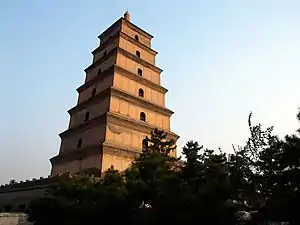 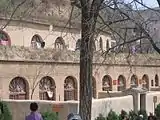 .jpg.webp) 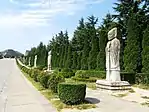 (clockwise from top)
| |
.svg.png.webp) Map showing the location of Shaanxi Province | |
| Coordinates: 35°36′N 108°24′E | |
| Country | China |
| Capital (and largest city) | Xi'an |
| Divisions | 10 prefectures, 107 counties, 1745 townships |
| Government | |
| • Type | Province |
| • Body | Shaanxi Provincial People's Congress |
| • CCP Secretary | Liu Guozhong |
| • Congress chairman | Liu Guozhong |
| • Governor | Zhao Yide |
| • CPPCC chairman | Xu Xinrong |
| Area | |
| • Total | 205,800 km2 (79,500 sq mi) |
| • Rank | 11th |
| Highest elevation (Mount Taibai) | 3,771 m (12,372 ft) |
| Population (2020)[2] | |
| • Total | 39,530,000 |
| • Rank | 16th |
| • Density | 190/km2 (500/sq mi) |
| • Rank | 21st |
| Demographics | |
| • Ethnic composition | Han – 99.5% Hui – 0.4% |
| • Languages and dialects | Zhongyuan Mandarin, Southwestern Mandarin, Jin |
| ISO 3166 code | CN-SN |
| GDP (2020) | CNY 2.618 trillion USD 380 billion (14th)[3] |
| - per capita | CNY 66,234 USD 9,599 (14th) |
| • growth | |
| HDI (2019) | high · 13th |
| Website | www.shaanxi.gov.cn (Simplified Chinese) |
Shaanxi covers an area of over 205,000 km2 (79,151 sq mi) with about 37 million people, the 16th highest in China. Xi'an – which includes the sites of the former Chinese capitals Fenghao and Chang'an – is the provincial capital as well as the largest city in Northwest China[5] and also one of the oldest cities in China and the oldest of the Four Great Ancient Capitals, being the capital for the Western Zhou, Western Han, Jin, Sui and Tang dynasties.[6] Xianyang, which served as the Qin dynasty capital, is just north across Wei River. The other prefecture-level cities into which the province is divided are Ankang, Baoji, Hanzhong, Shangluo, Tongchuan, Weinan, Yan'an and Yulin.
The province is geographically divided into three parts, namely Northern, Central and Southern Shaanxi. Northern Shaanxi (or "Shaanbei") makes up the southeastern portion of the Ordos Basin and mainly comprises the two prefectural cities of Yulin and Yan'an on the northern Loess Plateau, demarcated from the Ordos Desert and the grasslands of Inner Mongolia's Ordos City by the Ming Great Wall. Central Shaanxi (or "Shaanzhong") is also known as the Guanzhong region and comprises the drainage basin of lower Wei River east of Mount Long and north of the Qinling Mountains, where the majority of Shaanxi's population reside. Southern Shaanxi (or "Shaannan") comprises the three prefectural cities in the edge of the historical Bashu region south of the Qinling Mountains and includes the three mountainous cities of Hanzhong, Ankang and Shangluo.
Along with areas of adjacent Shanxi and Henan provinces, it formed the cradle of Chinese civilization. In the Republican era of China, the city of Yan'an was near the endpoint of the Long March which destroyed the Chinese Soviet Republic in Jiangxi by the Kuomintang armies, and became the birthplace of the Chinese Communist Revolution from late 1935 to early 1947 and the Communists formed the Shaan-Gan-Ning Border Region in constituent parts of Shaanxi.
The vast majority of the population of Shaanxi is Han Chinese. Mandarin is mainly spoken in Shaanxi, including Zhongyuan Mandarin and Southwestern Mandarin; another variety of Chinese, Jin (Shanxi Hua), is also spoken.
Shaanxi is China's 15th largest economy, ranking within the middle among China's administrative divisions. The fossil fuel and high technology sectors compose the two largest industries in Shaanxi Province. The high technology sector includes aircraft and aerospace industries and Shaanxi produces more than 50% of the R&D and manufacturing equipment for the country's domestic commercial aviation industry.[7]
Name
| Shaanxi | |||||||||||||||||||||||||||||||||||||
|---|---|---|---|---|---|---|---|---|---|---|---|---|---|---|---|---|---|---|---|---|---|---|---|---|---|---|---|---|---|---|---|---|---|---|---|---|---|
.svg.png.webp) "Shaanxi" in Simplified (top) and Traditional (bottom) Chinese characters | |||||||||||||||||||||||||||||||||||||
| Chinese name | |||||||||||||||||||||||||||||||||||||
| Simplified Chinese | 陕西 | ||||||||||||||||||||||||||||||||||||
| Traditional Chinese | 陝西 | ||||||||||||||||||||||||||||||||||||
| Hanyu Pinyin | Shǎnxī | ||||||||||||||||||||||||||||||||||||
| Postal | Shensi | ||||||||||||||||||||||||||||||||||||
| Literal meaning | "West of the Shǎn (Pass)" | ||||||||||||||||||||||||||||||||||||
| |||||||||||||||||||||||||||||||||||||
| Dunganese name | |||||||||||||||||||||||||||||||||||||
| Dungan | Шанщи | ||||||||||||||||||||||||||||||||||||
The name of the province, 陝西, means "Shan's West", referring to Shan plateau (陝塬), now known as Zhanbian plateau.[8] The usage "West from Shan" (自陝而西) first appeared in a text circa 200 BC about how the Duke of Zhou divided feudal lands.[9]
The transcriptions of 陝西 and its neighbouring province 山西 are troublesome for Beijing Mandarin-based transcriptions, which pronounces both as /ʂan ɕi/ only with a different tone (Shǎnxī and Shānxī). To avoid tone marks, "Shaanxi" (![]() listen) was promoted by the Gwoyeu Romatzyh scheme in 1928. This spelling trouble, however, would not have occurred for the more archaic Chinese languages native to the two provinces, which pronounce Shaanxi like "Shie-sei" and Shanxi like "San-sei". For instance, Jin language in Wubu County distinguishes 陝西 /ʂie sɛe/ from 山西 /sã sɛe/, Jin language in Lin County distinguishes 陝西 /ʂɻə sei/ from 山西 /sæ sei/, Central Plains Mandarin in Xianyang distinguishes 陝西 /ʂã ɕi/ from 山西 /sã ɕi/.
listen) was promoted by the Gwoyeu Romatzyh scheme in 1928. This spelling trouble, however, would not have occurred for the more archaic Chinese languages native to the two provinces, which pronounce Shaanxi like "Shie-sei" and Shanxi like "San-sei". For instance, Jin language in Wubu County distinguishes 陝西 /ʂie sɛe/ from 山西 /sã sɛe/, Jin language in Lin County distinguishes 陝西 /ʂɻə sei/ from 山西 /sæ sei/, Central Plains Mandarin in Xianyang distinguishes 陝西 /ʂã ɕi/ from 山西 /sã ɕi/.
In older texts, Shaanxi was written as Shensi, as early as 1748.[10] "Shensi" was recognized in the 1906 Chinese postal romanization. "Shensi" continued to be popular alongside "Shaanxi" until 1987 when the PRC officially banned pre-PRC romanizations.[11]
History
Shaanxi is considered one of the cradles of Chinese civilization. Thirteen feudal dynasties established their capitals in the province during a span of more than 1,100 years, from the Zhou dynasty to the Tang dynasty.
The province's principal city and current capital, Xi'an, is one of the four great ancient capitals of China and is the eastern terminus of the Silk Road, which leads to Europe, the Arabian Peninsula and Africa.
Under the Han dynasty, the Northern Silk Road was expanded to advance exploration and military purposes to the west. This Northern Silk Road is the northernmost of the Silk Roads and is about 2,600 kilometres (1,600 mi) in length. It connected the ancient Chinese capital of Xi'an to the west over the Wushao Ling Pass to Wuwei and emerging in Kashgar before linking to ancient Parthia.[12]
The Northern Song dynasty established a Shaanxi Lu, (circuit) in the area, governed from modern Xi'an in 997. The Yuan dynasty established Shaanxi Province (Yuan dynasty), governed by a Branch Secretariat in 1286.[13]
Under the Ming dynasty, Shaanxi was established with the founding of the Saanxi Provincial Administration Commission in 1376, whose administration also included the modern provinces of Gansu, Ningxia, and part of Qinghai.[13] In the Ming, most visitors from Central Asia and West Asia entered the country via Shaanxi.[14]
One of the most devastating earthquakes in history occurred near Hua Shan, in south-eastern part of Shaanxi Province on January 23, 1556, killing an estimated 830,000 people (see 1556 Shaanxi earthquake).
After the founding of the Qing dynasty, Gansu was split from Shaanxi, but both provinces were governed under the Viceroy of Shaan-Gan.
The end of the short-lived Jiangxi Soviet signaled the beginning of the Long March by Mao Zedong and the Chinese Communists to the Shaanxi Soviet at Yan'an.
Pre-historic site
The Lantian Man site, with hominin fossils of one million years ago, was found in Lantian County in northwestern Shaanxi province, near the city of Xi'an. Scientists classify Lantian Man as a subspecies of Homo erectus. The fossils are displayed at the Shaanxi History Museum, Xi'an, China.
Geography
The geography of the area is described as being part of the Ordos Desert in the north along the border with Inner Mongolia, the Loess Plateau in the central part of the province, the Qin Mountains (Qinling) running east to west in the south central part, and subtropical climate south of the Qinling. In between the Loess Plateau and the Qinling lies the Wei River Valley, or Guanzhong, a cradle of early Chinese civilization.
Going clockwise, Shaanxi borders Shanxi (E, NE), Henan (E), Hubei (SE), Chongqing (S), Sichuan (SW), Gansu (W), Ningxia (NW), and Inner Mongolia (N). In terms of number of bordering provincial-level divisions, Shaanxi ties Inner Mongolia.
Due to its large span in latitude, Shaanxi has a variety of climates. Under the Köppen climate classification, the northern parts, including the Loess Plateau, have either a cold arid (Köppen BWk) or cold semi-arid (Köppen BSk), with cold and very dry winters, dry springs and autumns, and hot, humid summers. The area known as Guanzhong is mostly semi-arid, though there are a few areas with a humid subtropical climate (Köppen Cwa), with cool to cold winters, and hot, humid summers that often see early-season heatwaves. The southern portion is much more humid and lies in the humid subtropical zone, with more temperate winters and long, hot, humid summers. Annual mean temperature is roughly between 8 to 16 °C (46 to 61 °F), with January temperatures ranging from −11 to 3.5 °C (12.2 to 38.3 °F) and July temperatures ranging from 21 to 28 °C (70 to 82 °F).
Besides the provincial capital of Xi'an, other cities include: Baoji, Hanzhong, Lintong, Tongchuan, Xianyang, Yan'an and Ankang.
Administrative divisions
Shaanxi consists of ten prefecture-level divisions: all prefecture-level cities (including a sub-provincial city):
| Administrative divisions of Shaanxi | ||||||||||
|---|---|---|---|---|---|---|---|---|---|---|
| Division code[15] | Division | Area in km2[16] | Population 2010[17] | Seat | Divisions[18] | |||||
| Districts | Counties | CL cities | ||||||||
| 610000 | Shaanxi Province | 205800.00 | 37,327,378 | Xi'an city | 30 | 71 | 6 | |||
| 610100 | Xi'an city | 10096.81 | 8,467,837 | Weiyang District | 11 | 2 | ||||
| 610200 | Tongchuan city | 3884.81 | 834,437 | Yaozhou District | 3 | 1 | ||||
| 610300 | Baoji city | 18116.93 | 3,716,731 | Jintai District | 3 | 9 | ||||
| 610400 | Xianyang city | 10323.99 | 4,894,834 | Qindu District | 3 | 9 | 2 | |||
| 610500 | Weinan city | 13030.56 | 5,286,077 | Linwei District | 2 | 7 | 2 | |||
| 610600 | Yan'an city | 37030.54 | 2,187,009 | Baota District | 2 | 10 | 1 | |||
| 610700 | Hanzhong city | 27096.43 | 3,416,196 | Hantai District | 2 | 9 | ||||
| 610800 | Yulin city | 42920.18 | 3,351,437 | Yuyang District | 2 | 9 | 1 | |||
| 610900 | Ankang city | 23536.31 | 2,629,906 | Hanbin District | 1 | 9 | ||||
| 611000 | Shangluo city | 19587.31 | 2,341,742 | Shangzhou District | 1 | 6 | ||||
Sub-provincial cities | ||||||||||
| Administrative divisions in Chinese and varieties of romanizations | ||||
|---|---|---|---|---|
| English | Chinese | Pinyin | ||
| Shaanxi Province | 陕西省 | Shǎnxī Shěng | ||
| Xi'an city | 西安市 | Xī'ān Shì | ||
| Tongchuan city | 铜川市 | Tóngchuān Shì | ||
| Baoji city | 宝鸡市 | Bǎojī Shì | ||
| Xianyang city | 咸阳市 | Xiányáng Shì | ||
| Weinan city | 渭南市 | Wèinán Shì | ||
| Yan'an city | 延安市 | Yán'ān Shì | ||
| Hanzhong city | 汉中市 | Hànzhōng Shì | ||
| Yulin city | 榆林市 | Yúlín Shì | ||
| Ankang city | 安康市 | Ānkāng Shì | ||
| Shangluo city | 商洛市 | Shāngluò Shì | ||
The ten prefecture-level cities of Shaanxi are subdivided into 107 county-level divisions (30 districts, 4 county-level cities, and 73 counties).
Urban areas
| Population by urban areas of prefecture & county cities | |||||
|---|---|---|---|---|---|
| # | City | Urban area[19] | District area[19] | City proper[19] | Census date |
| 1 | Xi'an[lower-alpha 1] | 5,206,253 | 6,501,190 | 8,467,838 | 2010-11-01 |
| (1) | Xi'an (new districts)[lower-alpha 1] | 389,830 | 889,854 | see Xi'an | 2010-11-01 |
| 2 | Baoji | 871,940 | 1,437,802 | 3,716,737 | 2010-11-01 |
| 3 | Xianyang[lower-alpha 2] | 730,704 | 945,420 | 5,096,001 | 2010-11-01 |
| 4 | Tongchuan | 463,866 | 743,277 | 834,437 | 2010-11-01 |
| 5 | Yulin[lower-alpha 3] | 429,189 | 637,617 | 3,351,436 | 2010-11-01 |
| (5) | Yulin (new district)[lower-alpha 3] | 114,188 | 288,053 | see Yulin | 2010-11-01 |
| 6 | Ankang | 379,707 | 870,126 | 2,629,906 | 2010-11-01 |
| 7 | Hanzhong[lower-alpha 4] | 350,167 | 534,923 | 3,416,196 | 2010-11-01 |
| (7) | Hanzhong (new district)[lower-alpha 4] | 144,596 | 471,634 | see Hanzhong | 2010-11-01 |
| 8 | Weinan[lower-alpha 5] | 347,484 | 877,142 | 5,286,077 | 2010-11-01 |
| (8) | Weinan (new district)[lower-alpha 5] | 107,467 | 322,148 | see Weinan | 2010-11-01 |
| 9 | Yan'an[lower-alpha 6] | 336,856 | 475,234 | 2,187,009 | 2010-11-01 |
| (9) | Yan'an (new district)[lower-alpha 6] | 74,945 | 171,552 | see Yan'an | 2010-11-01 |
| (10) | Shenmu[lower-alpha 7] | 282,650 | 455,493 | see Yulin | 2010-11-01 |
| 11 | Xingping | 247,539 | 541,554 | see Xianyang | 2010-11-01 |
| 12 | Hancheng | 196,574 | 391,164 | see Weinan | 2010-11-01 |
| 13 | Shangluo | 156,781 | 531,696 | 2,341,742 | 2010-11-01 |
| 14 | Huayin | 127,987 | 258,113 | see Weinan | 2010-11-01 |
| (15) | Binzhou[lower-alpha 8] | 106,710 | 171,462 | see Xianyang | 2010-11-01 |
| 16 | Yangling[lower-alpha 2] | 104,944 | 201,172 | see Xianyang | 2010-11-01 |
- New districts established after census: Gaoling (Gaoling County), Huyi (Huxian County). These new districts not included in the urban area & district area count of the pre-expanded city.
- Yangling is a satellite urban area separated from Xianyang and it is not included in the urban area & district area count.
- New district established after census: Hengshan (Hengshan County). The new district not included in the urban area & district area count of the pre-expanded city.
- New district established after census: Nanzheng (Nanzheng County). The new district not included in the urban area & district area count of the pre-expanded city.
- New district established after census: Huazhou (Huaxian County). The new district not included in the urban area & district area count of the pre-expanded city.
- New district established after census: Ansai (Ansai County). The new district not included in the urban area & district area count of the pre-expanded city.
- Shenmu County is currently known as Shenmu CLC after census.
- Binxian County is currently known as Binzhou CLC after census.
Politics
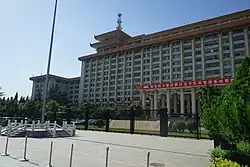
The politics of Shaanxi is structured in a triple party-government system like all other governing institutions in mainland China.
The Governor of Shaanxi is the highest-ranking official in the People's Government of Shaanxi. However, in the province's dual party-government governing system, the Governor is considered to have less power than the Shaanxi Chinese Communist Party Provincial Committee Secretary (中共陕西省委书记), colloquially termed the "Shaanxi CCP Party Chief"; since the Governor is always ranked as the First-Deputy Secretary in the Shaanxi Chinese Communist Party Provincial Committee.
Shaanxi was established as a provincial government since Qing dynasty. On 10 January 1950, the People's Government of Shaanxi was established in Xi'an. Ma Minfang was then appointed as the first Governor of Shaanxi.
Economy
As of the mid-19th century, Shaanxi exported animal skins, wine, liquor, and musk. Money loans were also common, with Shaanxi business people involved in the Guangzhou loan business. Shaanxi commonly imported European animal skins, watches, Chinese language books, and cloth.[20]
The fossil fuel and high technology sectors compose the two largest industries in Shaanxi province. During 2009, the province ranked third in China for production of coal, natural gas and crude oil.[7] As the home of several of the leading universities and research institutes in Western China, Shaanxi province also plays a major role in China's burgeoning aircraft and aerospace industries, producing more than 50% of the R&D and manufacturing equipment for the country's domestic commercial air industry.[7] Nominal GDP for 2011 was 1,239 billion RMB (US$196.7 billion) and GDP per capita was 21,729 RMB (US$3,179), ranking 17th in the PRC.
In the first half of 2019, Shaanxi's total production value reached 1,162.557 billion yuan, a year-on-year increase of 5.4%. The added value of the primary industry was 55.319 billion yuan, an increase of 4.5%; the second industry was 557.935 billion yuan, an increase of 4.2%; the tertiary industry was 549.303 billion yuan, an increase of 6.8%.[21]
Baoji Hi-Tech Industrial Development Zone
Established in 1992, Baoji Hi-Tech Industrial Development Zone was approved as a national hi-tech zone by the State Council. It has a long-term planned area of 40 km2 (15 sq mi). The transportation system around the zone includes Xi'an-Xianyang International Airport and National Highway 310, and industries operating within the zone include auto parts, electronics, IT, pharmaceuticals and bioengineering industries and new materials.[22]
Shaanxi Xi'an Export Processing Zone
Shaanxi Xi'an Export Processing Zone (XEPZ) was approved on 21 June 2002 by the State Council for its establishment and was put on 5 April 2004. As the first state-level export processing zone in northwest China, XEPZ has become one of the seven pioneer EPZs with the function of bonded logistics in China. XEPZ is under the leadership of the Administrative Committee of Xi'an Economic and Technological Development Zone (XETDZ), which is designated by Xi'an municipal government to exercise economic and administrative power within the zone. XEPZ is a special economic zone. By now, there are more than 40 enterprises home and abroad settled in XEPZ. The pillar industries feature aviation, machinery, electronics and new energy.[23]
Western Triangle
The Western Triangle is a new economic zone composing the three major city-level economies of Western China: Xi'an, Chongqing and Chengdu. It is believed that the addition of Xi'an to the Triangle will spur economic growth in the region and allow the city an opportunity to capitalize on the commercial potential of its high-technology industries.[7]
Xi'an Economic and Technological Development Zone
Established in 1993, Xi'an Economic and Technology Development Zone was approved as a national zone in 2000. The zone is 20 minutes from Xi'an Xianyang International Airport, and national highways pass through. It has formed four pillar industries: automotive, electronics, food, and new materials industries. So far, the zone has attracted more than 1,700 enterprises.[24]
Xi'an High-tech Industrial Development Zone
Xi'an HTDZ opened its gates in 1991. It was established as a "pivotal location" for investment by high-tech industry companies in central and northwest China. Established in 1991, Xi'an Hi-Tech Industrial Development Zone is a national high-tech zone. It is surrounded by national highways and it is 30 minutes from Xi'an International Airport. Furthermore, it is ranked in the top three high-tech zones in China.[25]
Xi'an Software Park
Xi'an Software Park, established in December 1998, is the professional park for Xi'an to develop scale software and service outsourcing industries. The park has been appraised as a software industry base under the National Torch Program, national software industry base, national software export base, city demonstrational area of national service outsourcing base. It is one of the four parks with "double bases" of software in China. Xi'an Software Park assembles 90% of enterprises engaging in software and service outsourcing in Xi'an. There were nearly 780 companies, of which foreign-funded enterprises account for 170, and over 71,000 jobholders in the park by the end of 2008.[26]
Yangling Agriculture Hi-Tech Industrial Zone
Yangling Agriculture Hi-Tech Industrial Zone was approved as a national-level hi-tech development zone by State Council in 1997. It is 82 km (51 mi) from Xi'an to the east and 70 km (43 mi) from Xi'an Xianyang International Airport.[27]
Demographics
Nearly all the people in Shaanxi are ethnic Han Chinese, with pockets of Hui population in the northwestern region (adjacent to Ningxia). Shaanxi province is one of the centers of ancient Chinese civilization. The central part of Shaanxi, known as Guanzhong, where the provincial capital Xi'an is located, is more populous compared to the others (Shaannan and Shaanbei),
|
| |||||||||||||||||||||||||||||||||||||||
| Xi'an part of Shaanxi Province until 1947; dissolved in 1954 and incorporated into Shaanxi Province. | ||||||||||||||||||||||||||||||||||||||||
Religion
The predominant religions in Shaanxi are Chinese folk religions, Taoist traditions and Chinese Buddhism. According to surveys conducted in 2007 and 2009, 7.58% of the population believes and is involved in ancestor veneration, while 1.57% of the population identifies as Christian.[38] The reports didn't give figures for other types of religion; 90.85% of the population may be either irreligious or involved in worship of nature deities, Buddhism, Confucianism, Taoism, folk religious sects, and small minorities of Muslims.
|
- Catholic Church in Shaanxi
- Catholic Church in Zhifang, destroyed in 2017
- Golden Lampstand Church, destroyed in 2018
Culture

- Shaanxi cuisine
- Qinqiang, the representative folk opera of Shaanxi
- Shaanxi shadow play
- Xintianyou
- Also see Xi'an#Culture
Tourism
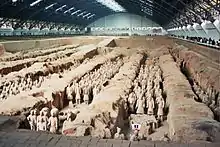
- Banpo Neolithic village, near Xi'an
- Biángbiáng noodles, one of the "ten strange wonders of Shaanxi" (陝西十大怪)
- Daqin Pagoda
- Mount Hua, one of the five best known mountains in China.
- Taibaishan (Mount Taibai), the highest peak of the Qinling Range.
- Mausoleum and Terracotta Army Museum of the First Qin Emperor in Xi'an (World Heritage Site)
- The city of Xi'an: City Walls, Great Mosque, Bell Tower and Drum Tower, Forest of Stone Steles Museum, Shaanxi History Museum, Wild Goose Pagoda
- Yan'an, the destination of the Long March and the center of Chinese Communist revolution from 1935 to 1948
- Zhao Mausoleum
Media
- Shaanxi Radio serves Xi'an and the surrounding Shaanxi province area with music and news.
- The Story of Yue Fei, a 17th–18th century wuxia novel about the life of Song dynasty general Yue Fei, says his military arts teacher, Zhou Tong, was from Shaanxi.[39]
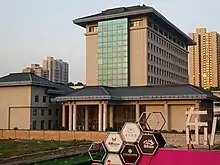
Education
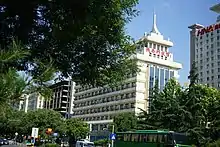
Sports
Professional sports teams based in Shaanxi include:
- Chinese Basketball Association
- Southern Division: Shaanxi Kylins
- National Basketball League (NBL): Shaanxi Wolves
- Women's Chinese Basketball Association (WCBA): Shaanxi Red Wolves
- Chinese Football Association
- China League One: Shaanxi Chang'an Athletic F.C.
See also
- List of prisons in Shaanxi
- Major national historical and cultural sites in Shaanxi
Notes
- The data was collected by the Chinese General Social Survey (CGSS) of 2009 and by the Chinese Spiritual Life Survey (CSLS) of 2007, reported and assembled by Xiuhua Wang (2015)[38] in order to confront the proportion of people identifying with two similar social structures: ① Christian churches, and ② the traditional Chinese religion of the lineage (i. e. people believing and worshipping ancestral deities often organised into lineage "churches" and ancestral shrines). Data for other religions with a significant presence in China (deity cults, Buddhism, Taoism, folk religious sects, Islam, et al.) was not reported by Wang.
- This may include:
- Buddhists;
- Confucians;
- Deity worshippers;
- Taoists;
- Members of folk religious sects;
- And people not bounded to, nor practicing any, institutional or diffuse religion.
References
- "Doing Business in China – Survey". Ministry of Commerce of the People's Republic of China. Archived from the original on 26 May 2014. Retrieved 5 August 2013.
- "Communiqué of the Seventh National Population Census (No. 3)". National Bureau of Statistics of China. 11 May 2021. Retrieved 11 May 2021.
{{cite web}}: CS1 maint: url-status (link) - GDP-2020 is a preliminary data "Home - Regional - Quarterly by Province" (Press release). China NBS. 1 March 2021. Retrieved 23 March 2021.
- "Sub-national HDI - Subnational HDI - Global Data Lab". globaldatalab.org. Retrieved 17 April 2020.
- 最新中国城市人口数量排名(根据2010年第六次人口普查). www.elivecity.cn (in Chinese (China)). Archived from the original on 3 March 2015. Retrieved 12 June 2019.
- "Xi'an - MSN Encarta". 28 February 2008. Archived from the original on 28 February 2008. Retrieved 12 June 2019.
- "China Economy @ China Perspective". Archived from the original on 8 October 2011. Retrieved 25 October 2011.
- 赵慎珠 (10 February 2017). "陕州地坑院 民居活化石". Henan Daily. Archived from the original on 13 June 2022.
- 在舟 (8 March 2022). "陕西之名因何而来,陕东在哪里?". 环球情报员 – via 澎湃新闻.
- Rathlefs, Ernst Ludewig (1748). Pastoris primarii zu Diepholz, Akridotheologie Oder historische und theologische Betrachtungen über die Heuschrekken, Volume 1 (in German). p. 38.
der Landschaft Shensi [陝西]
- "陕西为什么拼作Shaanxi,而不是Shanxi". 澎湃新闻. 7 July 2016.
- "Silk Road, North China, C.Michael Hogan, the Megalithic Portal, ed. A. Burnham". Archived from the original on 2 October 2013. Retrieved 26 December 2007.
- Dictionary of the Ben cao gang mu, Volume 2: Geographical and Administrative Designations First Edition, Paul Unschuld, Series Editor Edition by Hua Linfu (Author), Paul D. Buell (Author), Paul U. Unschuld (Editor)
- Chen, Yuan Julian (11 October 2021). "Between the Islamic and Chinese Universal Empires: The Ottoman Empire, Ming Dynasty, and Global Age of Explorations". Journal of Early Modern History. 25 (5): 422–456. doi:10.1163/15700658-bja10030. ISSN 1385-3783. S2CID 244587800.
- 中华人民共和国县以上行政区划代码 (in Simplified Chinese). Ministry of Civil Affairs. Archived from the original on 2 April 2015. Retrieved 11 December 2015.
- Shenzhen Bureau of Statistics. 《深圳统计年鉴2014》 (in Simplified Chinese). China Statistics Print. Archived from the original on 12 May 2015. Retrieved 29 May 2015.
- Census Office of the State Council of the People's Republic of China; Population and Employment Statistics Division of the National Bureau of Statistics of the People's Republic of China (2012). 中国2010人口普查分乡、镇、街道资料 (1 ed.). Beijing: China Statistics Print. ISBN 978-7-5037-6660-2.
- Ministry of Civil Affairs (August 2014). 《中国民政统计年鉴2014》 (in Simplified Chinese). China Statistics Print. ISBN 978-7-5037-7130-9.
- 国务院人口普查办公室、国家统计局人口和社会科技统计司编 (2012). 中国2010年人口普查分县资料. Beijing: China Statistics Print. ISBN 978-7-5037-6659-6.
- Roberts, Edmund (1837). Embassy to the Eastern Courts of Cochin-China, Siam, and Muscat. New York: Harper & Brothers. p. 123. Archived from the original on 16 October 2013. Retrieved 16 October 2013.
- "Shaanxi GDP in 1st Half of 2019: Up by 5.4% – Cilitech". cilitech.com. Archived from the original on 31 July 2019. Retrieved 31 July 2019.
- "RightSite.asia | Baoji Hi-Tech Industrial Development Zone". Archived from the original on 26 January 2010. Retrieved 15 July 2010.
- "RightSite.asia | Shaanxi Xi'an Export Processing Zone". Archived from the original on 25 January 2010. Retrieved 15 July 2010.
- "RightSite.asia | Xi'an Economic & Technological Development Zone". Archived from the original on 28 January 2010. Retrieved 15 July 2010.
- "RightSite.asia | Xi'an High-tech Industrial Development Zone". Archived from the original on 29 January 2010. Retrieved 15 July 2010.
- "RightSite.asia | Xi'an Software Park". Archived from the original on 30 April 2010. Retrieved 15 July 2010.
- "RightSite.asia | Yangling Agriculture Hi-Tech Industrial Zone". Archived from the original on 28 January 2010. Retrieved 15 July 2010.
- 1912年中国人口. Archived from the original on 24 September 2015. Retrieved 6 March 2014.
- 1928年中国人口. Archived from the original on 24 September 2015. Retrieved 6 March 2014.
- 1936–37年中国人口. Archived from the original on 24 September 2015. Retrieved 6 March 2014.
- 1947年全国人口. Archived from the original on 13 September 2013. Retrieved 6 March 2014.
- 中华人民共和国国家统计局关于第一次全国人口调查登记结果的公报. National Bureau of Statistics of China. Archived from the original on 5 August 2009.
- 第二次全国人口普查结果的几项主要统计数字. National Bureau of Statistics of China. Archived from the original on 14 September 2012.
- 中华人民共和国国家统计局关于一九八二年人口普查主要数字的公报. National Bureau of Statistics of China. Archived from the original on 10 May 2012.
- 中华人民共和国国家统计局关于一九九〇年人口普查主要数据的公报. National Bureau of Statistics of China. Archived from the original on 19 June 2012.
- 现将2000年第五次全国人口普查快速汇总的人口地区分布数据公布如下. National Bureau of Statistics of China. Archived from the original on 29 August 2012.
- "Communiqué of the National Bureau of Statistics of People's Republic of China on Major Figures of the 2010 Population Census". National Bureau of Statistics of China. Archived from the original on 27 July 2013.
- China General Social Survey 2009, Chinese Spiritual Life Survey (CSLS) 2007. Report by: Xiuhua Wang (2015, p. 15) Archived 2015-09-25 at the Wayback Machine
- Qian, Cai. General Yue Fei. Trans. Honorable Sir T.L. Yang. Joint Publishing (H.K.) Co., Ltd., 1995. ISBN 978-962-04-1279-0.
External links
- Official website (in Chinese)
- Economic profile for Shaanxi at HKTDC
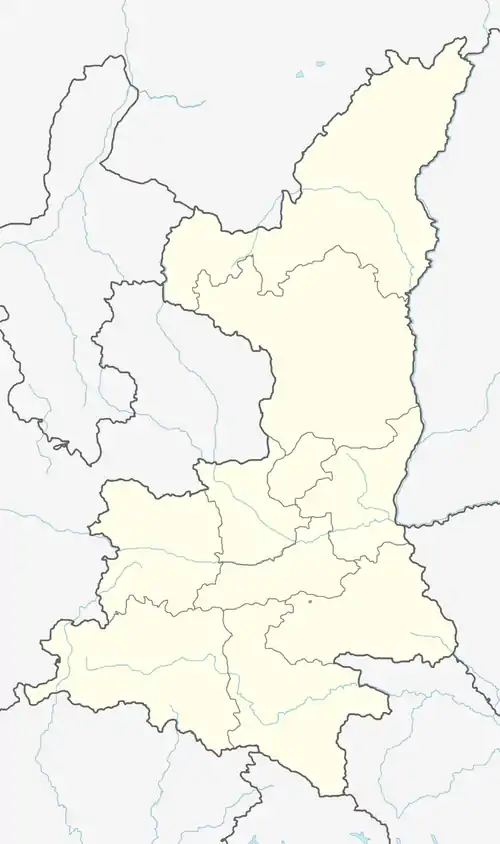

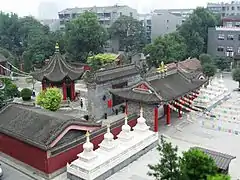
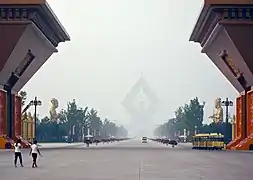
.jpg.webp)
